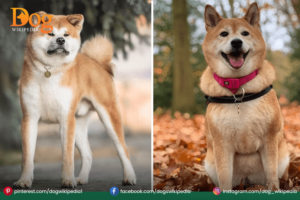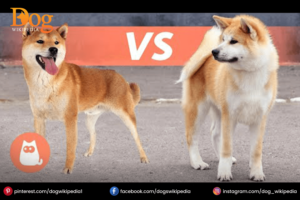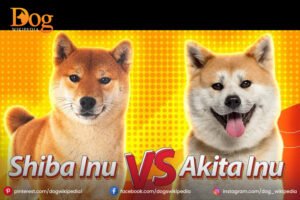Akita Inu vs Shiba Inu: Introduction
Akita Inu
The magnificent and strong Akita Inu is the national breed of Japan and has a long and illustrious history. Bred to hunt big game, protect the aristocracy, and be devoted friends, this historic breed originated in the prefecture of Akita.
Devoted and watchful disposition
– Sharp minds and flexible dispositions
– Thick, multicolored double coats
– Physical characteristics and athleticism
-10- to 12-year lifespan on average
Shiba Inu
The smallest and oldest native breed in Japan, the Shiba Inu is a little, nimble dog that resembles a fox. Shibas are bred to hunt tiny prey and are
-Self-assured and self-sufficient
-Intelligent but occasionally obstinate

1-Living requirements of Akita Inu vs Shiba Inu
Because of their size and active lifestyle, Akita Inus need vast living spaces, preferably with a yard. They require shelter from heat and do best in cooler climates of 40 to 70°F. For their physical and emotional health, they need to exercise for 30 to 60 minutes a day, which might include playing, walks, and runs.
Their attitude greatly depends on early socialization and patient teaching. Akitas like loyalty and human contact, therefore they are good for households with young children as long as supervision is provided. Shiba Inu on the other hand, require less yard space and may adapt to smaller living areas like apartments or condos. When it comes to exercise, they require only 15 to 30 minutes a day, which is quite low maintenance.
2-Growming needs of Akita Inu vs Shiba Inu
Active families can find faithful friends in Akitas, who possess intelligence and reserve. They are Periodic washing (every two to three months) keeps coat health. Dental maintenance, ear cleanings, and regular nail cutting (every 4-6 weeks) are crucial.
Shiba Inus require frequent brushing (two to three times per week) to avoid matting because they have double coats as well. They shed somewhat all year round, but more in the spring and fall. Bathing once a month keeps coat health and skin problems at bay.
3- Physical characteristics of Akita Inu vs Shiba Inu
Brindle, sesame, or white hues are available for its thick, curling double coat. In contrast, the Shiba Inu has a compact, athletic frame, a wedge-shaped head, and is smaller, standing 13–17 inches tall and weighs 15–25 pounds. Available in red, black, sesame, or white, the Shiba’s double coat is strong and straight.
Triangular ears and curled tails draped over the backs are backs are features common to both breeds. Their body form, coat, and stature all show noticeable variances despite their common Asian ancestry.
4-Personality of Akita Inu vs Shiba Inu
Akita Inus
-Faithful and shielding
– Perceptive and able to learn
– Brave and self-assured
– Loving toward family
– Guarded around unfamiliar people
– Lighthearted but also carefree
– Occasionally
Shiba Inu
– Self-reliant and unyielding
– Self-assured yet distant
– Faithful to relatives and cautious of outsiders
– Possessing a strong prey drive and hunting instinct

5- Temperament of Akita Inu vs Shiba Inu
Because of their backgrounds and intended uses, the Akita and Shiba Inus have different temperaments. The Akita Inu is renowned for being a devoted and protective dog that frequently forms close relationships with its family. Although this occasionally results in aloofness, they can be reserved around strangers, which makes them great watchdogs.
Shiba Inu, on the other hand, are more free-spirited and independent, and they frequently have an inquisitive and lively attitude. Although they are affectionate, they need constant training because they are more stubborn.
6- Exercise activity of Akita Inu vs Shiba Inu
Akita Inu
Level of Energy
Typically, moderate to high. They like to be active, but they also value relaxation and downtime.
Needs for Socialization
Since kids can be reticent with strangers, early socializing is essential to ensuring their well-being.
Shiba Inu
Exercise Requirements Shiba’s need to exercise for thirty to sixty minutes per day. They take pleasure in strolls, games, and intellectual stimulation.
7- Health consideration of Akita Inu vs Shiba Inu
Inus’ health considerations, each breed shows distinct vulnerabilities. Akita Inus are susceptible to conditions that might impair their quality of life, such as progressive retinal atrophy, autoimmune diseases, hip dysplasia, and some malignancies.
They usually live for ten to fifteen years, therefore in order to manage inherited diseases and keep a healthy weight, they need to have frequent veterinary examinations. On the other hand, although Shiba Inus can potentially develop hip dysplasia, they also frequently have disorders like patellar luxation, atopic dermatitis, and ocular problems.
8- Akita Inu vs Shiba Inu Training
Akita Inu Training
-Establish a clear direction Give praise
Early socialization, patience with independence, and an emphasis on protection and compliance
Shiba Inu Training
-Make use of incentives and treats
-Train briefly and with enjoyment, emphasizing fundamental adherence
-Be understanding when someone is obstinate. Promote problem-solving.
-Exchanged Training Advice
-Commence training early
-Show patience and positivity
– Use rewards rather than punishment
9- Family Suitability of Akita Inu Vs Shiba Inu
There are differences between Akita and Shiba Inus regarding family appropriateness. Akita Inus are devoted and protective pets, making them a good choice for households with older children (6+ years old). To control their protective tendencies, though, they need constant training and early socialization.
On the other hand, because they can be sensitive and independent, Shiba Inu are better suited for seasoned owners or households with older, peaceful children (8+ years).

Conclusion
Sum up, there are two different Japanese breeds—Akita and Shiba—each with their own special traits. Both breeds are bright and devoted, but Akita Inus make the best family guardians since they need constant training and early socialization. Shiba Inus are autonomous dogs that Shiba Inus are autonomous dogs that make good additions to households with older kids or experienced owners. The main distinctions are in trainability, energy levels, size, and grooming requirements.

